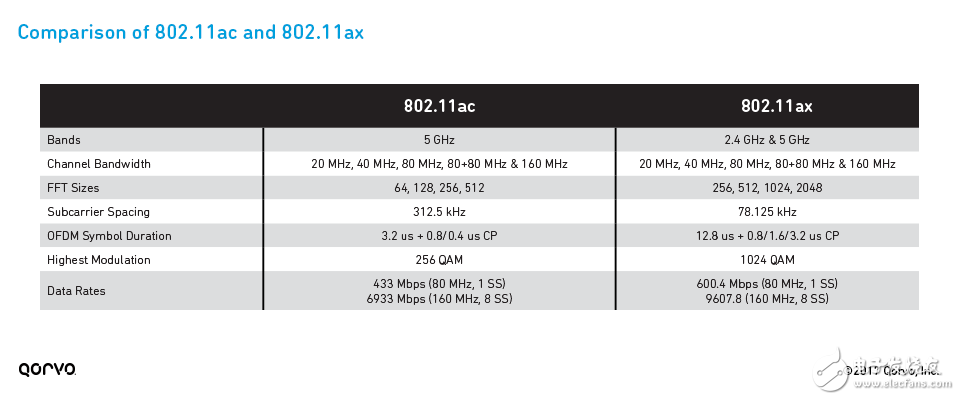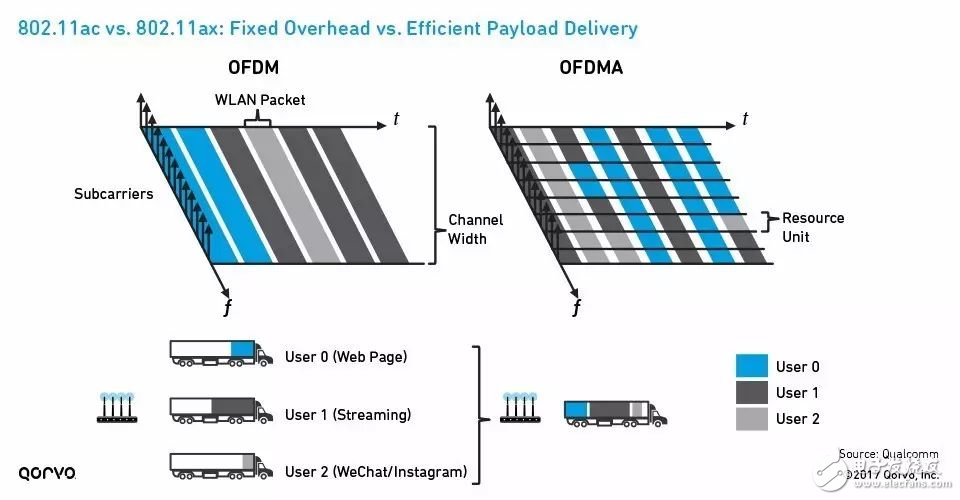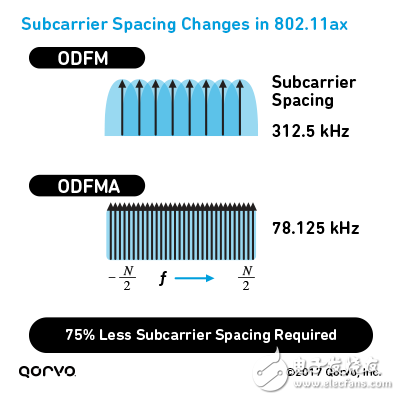Wi-Fi was originally just a 1x1 connection (single data stream, a single client communicating with the router), but now it has evolved into an 8x8 MIMO (multiple input/multiple output) solution where multiple clients communicate with the router at the same time. The current Wi-Fi standard, 802.11ac, was released at the end of 2013 and is very effective in the home environment. However, like the previous Wi-Fi standard, it will reach its limits by around 2022, according to estimates by the Organisation for Economic Co-operation and Development (OECD), when a family may have as many as 50 nodes. 802.11Ax is the next evolution of the IEEE 802.11 Wi-Fi standard, which will be widely used in very densely populated environments, such as urban apartment complexes, university campuses, concert venues, stadiums, etc., where many customers Both will access the Internet via Wi-Fi. This IEEE standard is currently under development and is expected to be released publicly in 2019. Below, we'll look at five key questions that readers should know about 802.11ax and next-generation Wi-Fi. What are the key differences between 802.11ac and 802.11ax? • Uplink MIMO: 802.11ac supports multi-user MIMO, but only in downlink mode. In contrast, 802.11ax adds uplink capabilities so multiple users can upload video at the same time. • Modulation: 802.11ax has a higher modulation scheme, upgrading from 256 QAM to 1024 QAM, which achieves higher throughput, increases capacity by 25%, and transmits 10 bits of data per symbol. • Capacity and efficiency improvements: 802.11ax uses OFDMA modulation instead of OFDM modulation, which enables FDD, which replaces TDD and enables resource unit allocation within a specific bandwidth. It also reduces the subcarrier spacing to 78.125 kHz, which is only 25% of the 802.11ac interval, and the symbol is four times longer than the latter. All of these changes combine to mean that the system is more efficient and can upload or download multiple packets at the same time instead of transferring only one packet at a time. • Based on scheduling rather than resource contention : In 802.11ax, the access point determines when the device is working and thus can process the client more efficiently. Resource scheduling also significantly reduces energy consumption during sleep, thereby extending the battery life of the client. See the table below for more differences between 802.11ac and 802.11ax. 02 802.11ac promises a network speed of 6.9 Gbps, but public Wi-Fi cannot achieve this speed. Will 802.11ax solve this problem? Speeds of 6.9 Gbps are not possible on a home or public Wi-Fi network. These theoretical speeds will never appear on the router box on the shelves of Best Buy, Wal-Mart or other large stores. The biggest limiting factor for home networks is the connection of Internet service providers, which is the conduit for Internet access for families. If the router can support 1.6 Gbps, but the home connection speed is only 100 Mbps, then the client will never be able to download faster from the wide area network (WAN). The data stream entering the home and access point will determine the initial Internet bandwidth benchmark. In these locations, other factors may slow down the network: 1 Distance between client and access point 2 Interference from other clients of the same frequency 3 Inherent Wi-Fi resource overhead, including acknowledgment, transmission, idle channel evaluation 802.11ax access points will provide a more efficient environment, eliminating Wi-Fi overhead issues. In other words, the fixed "cost" associated with communication is no longer part of the data transmission. 802.11ax will eliminate overhead in different ways, schedule device hours, and process information and clients more efficiently. In addition, advanced filtering techniques will achieve better coexistence and improved edge performance. This can produce two results: 1 Let the wider spectrum work 2 Improve service quality and range in previously restricted edge channels All in all, improved frequency and filtering will help 802.11ax achieve faster speeds than 802.11ac. 03 How does OFDMA create a more efficient payload transmission system? Each of the standards from 802.11a to 802.11ac uses OFDM (Orthogonal Frequency Division Multiplexing) technology to transmit Wi-Fi packets. In OFDM, whether it's transmitting video over a Wi-Fi network, or simply sending a simple text message, the device uses a fixed 20 MHz or 40 MHz bandwidth to transmit packets. However, 802.11ax uses OFDMA (Orthogonal Frequency Division Multiple Access) technology, which enables resource elements (RUs) to divide bandwidth according to client needs, providing the same customer experience for multiple users, and faster connection. . Below, we use trucks to make a simple metaphor to illustrate the difference between the two. As shown in the figure below, each truck is carrying a payload, which is user data. For example, one user is surfing the web, another user is uploading a video of a football game, and the third user is sending a text message. In OFDM, devices must use three trucks of the same size to send data, whether they are empty or full. In other words, OFDM uses bandwidth inefficiently, leaving a lot of blank space. In contrast, OFDMA allows devices to use RUs (ie, data) to fill an entire truck. The bandwidth utilization mode of this payload transmission mode is much higher. 04 802.11ax supports 1024 QAM. What is the impact of this higher modulation scheme? With 1024 QAM modulation, each symbol transmits 10 bits of data instead of 8 bits of 256 QAM. More bits are equal to more data, so its data payload transmission is more efficient, like having a bigger truck. At the same time, OFDMA also reduces the spacing between subcarriers, thereby loading more resource units into the truck. However, as the data rate increases, the error vector magnitude (EVM) of the RF front end also becomes large. With 1024 subcarriers in 802.11ax, the constellation will be very dense and the system must distinguish the constellation points. This requires a very advanced system to decode or demodulate these constellation points and also requires a device with a better EVM. 802.11ac requires a PA EVM of -35 dB and 802.11ax requires a PA EVM of -47 dB. Higher modulation schemes require better EVM, allowing devices to achieve higher packet transmission efficiency. 05 What are the differences between 802.11ax for mobile phones or other clients compared to access points? As mentioned above, 802.11ax reduces the EVM requirement to -47 dB, and both the access point and the client must meet the same specifications. There is no difference in this regard, but the power levels can vary widely. The operating power of an access point or customer premises equipment (CPE) is usually much higher than the client. The former has a power of 24 dBm, while the mobile phone has a power of 14-20 dBm. Ultimately, higher power means that the device must dissipate more heat, so the connection solution may require more stringent thermal requirements than the mobile solution. It is important to realize that the 802.11ax specification is still in constant change and will not be finalized for a certain period of time. As the next generation of Wi-Fi standards continues to evolve, we will continue to adjust. About the author Jeff Jones Senior Manager, Qorvo Application Engineering Since 2000, Jeff Jones has worked for Qorvo and has held various roles in test engineering, product engineering, design engineering, and application engineering. He is currently responsible for managing the mobile Wi-Fi application team. Fork Type Terminals,Insulated Bullet Sockets Terminals,Insulated Bullet Terminals,Type Fork Insulate Terminal Taixing Longyi Terminals Co.,Ltd. , https://www.txlyterminals.com





November 18, 2022